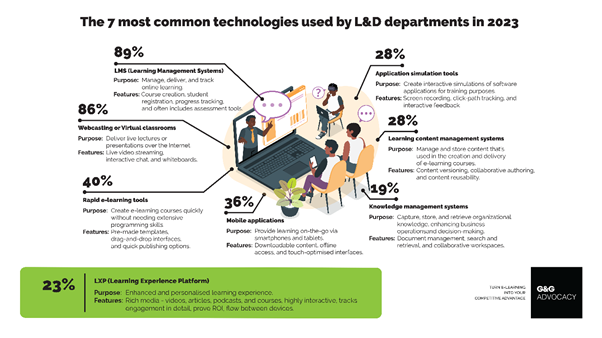eLearning experienced significant changes this year. Focus shifted from content to employees as L&D professionals pushed for eLearning solutions that support their organizational goals.
“The need for tangible returns on eLearning investments was pivotal for 2023,” said Michael Gullan, CEO of G&G Advocacy, an eLearning consultancy that assists organisations in transforming their workforce into a force.
L&D professionals sought deeper strategies, better, flexible technology, and sharp, relevant, interactive learning experiences, from gamified modules to large-scale mentorship and coaching.
“This year, we were privileged to see more organisations prioritizing eLearning to transform employees into high performers that drive businesses toward their goals,” Gullan added.

1. Content supports objectives
L&D professionals and eLearning specialists are putting employees first. A basic, standalone LMS (learning management system) is no longer enough. Uploading courses and information no longer cut it. 2023 welcomed deeper learning strategies aligned with and in support of business goals.
2. Focus on employees
2023 saw a shift in focusing on employees: What skills do our employees have? What skills do they need to meet the organisation’s goals? How can we close the skills gaps in an interesting, dynamic way? How can they apply their new skills in the flow of work?
3. Get an ROI
The days of uploading generic courses or learning content we think employees need are long gone. 2023 saw the growth of performance-focused eLearning that impacts the bottom line. eLearning strategies align with the organisation’s macro goals to enhance employees’ performance, passion, and shared vision.
4. Meet employees where they are
Training and development no longer happen at predetermined times and spaces. Employees want to connect with new learning material when they have the time, the need, and the mental space.
This can be in the office, at home, or when they’re on the move. They also want opportunities to apply their new skills in the workflow.
5. Mentorship and coaching at scale
L&D professionals and employees understand the benefits of being coached and mentored by leaders. eLearning is being used to coach and mentor employees at scale via a blend of mediums, such as webinars, simulated webinars, videos, and other interactive learning mediums. eLearning is also in high demand to upskill leaders on how to coach and mentor their teams better.
6. Beyond upskilling and reskilling
More organisations are using eLearning to lead key business-wide initiatives, such as mentoring and Coaching programmes, Diversity, Equity, Inclusion, Reskilling and Upskilling, Employee Well-Being, Career Development, Leadership Training, Digital Transformation, Compliance, and Hybrid work.
7. Employees have high expectations
Today’s employees are time-strapped, and their days are fraught with distractions. They expect hyper-focussed, targeted, and engaging interactive learning experiences that fit into their busy schedules. Importantly, they expect courses to be sharp and relevant, facilitating knowledge retention and application.
Employees also expect learning to address targeted upskill areas that will benefit them in life and the workplace.
8. The platform is key, but not everything
In 2023, employees expect eLearning to be intuitive and user-friendly, track their progress, and support them in meeting their learning KPIs. They want to switch between devices as they move through their day to optimize their time and catch up on their learning when and how it suits them.
9. Interactive and memorable learning experiences
Employees expect their online learning to be memorable, enjoyable, and gamified. They want simulations, case studies, and interactive quizzes to ensure their new skills and knowledge are applied and retained.
They want sharp, to-the-point, relevant courses and learning outcomes. Interesting videos, audio, decision trees, quizzes, and rich learning content are no longer nice to have––it’s expected.
10. Hybrid working, hybrid learning
Employees and organisations expect their eLearning to match how they work. Some want a fully online programme, and others want a blend of online and face-to-face methods, even if the instructor is on video via webinar. Most employees prefer webinars to in-person training so they can pause and rewatch learning material on demand.
“2023 welcomed many giant shifts in eLearning from content delivery to addressing organizational goals and employee needs,” said Gullan. Traditional course uploads on basic LMSs were replaced by hard-working strategies prioritizing skill acquisition via sharp, dynamic learning experiences.
Tangible ROI and alignment with broader organisational goals became paramount. Flexibility, convenience, and hyper-focused interactive learning content gained traction, as did incorporating mentorship, and coaching at scale.
“Organisations are demanding solutions that unite personalised, targeted learning with eLearning technology that supports employees to learn, retain and perform,” concluded Gullan.

